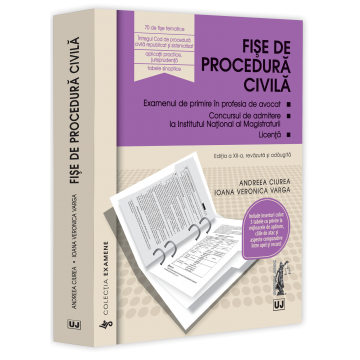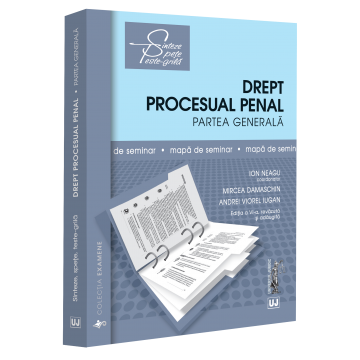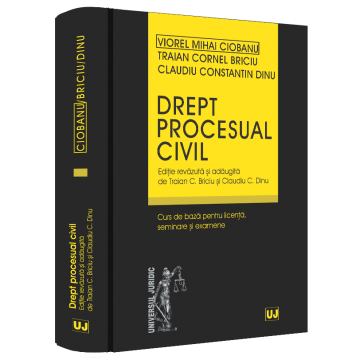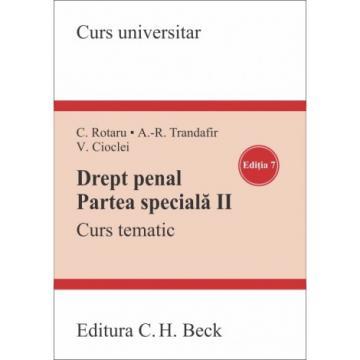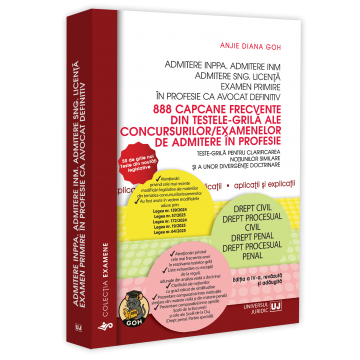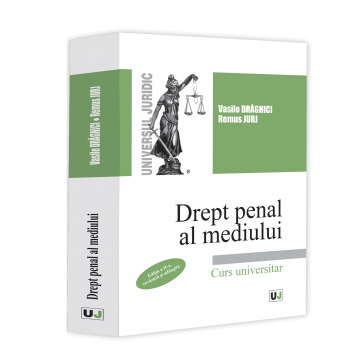ISBN: 978-606-28-0306-3
DOI: 10.5682/9786062803063
Publisher year: 2015
Edition: I
Pages: 314
Publisher: Editura Universitară
Author: Silvia Lucia Cristea
- Description
- Download (1)
- Authors
- Content
- More details
- Reviews (0)
This form of presentation is useful because it addresses the long-term memory of students through the logical connections between legal institutions but also because it can be a useful working tool for teachers who want to use slides to accompany university lectures.
Prof. univ. Dr. Silvia Lucia Cristea
-
Dreptul afacerilor pe intelesul studentilor economisti
Download
.jpg)
Silvia Lucia Cristea
Education:
Faculty of Law, University of Bucharest (1989);
postgraduate courses at the Institute of Comparative Law - Strasbourg (1991-1992);
excellent scholarship granted by the Ministry of Education of Quebec - Canada (1997);
Doctor in Law, specializing in international trade law (2001).
Activity:
researcher at the Institute of Legal Research of the Romanian Academy (1991-1993);
teaching assistant, lecturer, associate professor at the Academy of Economic Studies, Department of Law (1993 to present).
Publications:
monographs, books and specialized courses (21), including: "Bills in comparative law" (single author), Lumina Lex Publishing House, 2001, "Comments on the Fiscal Procedure Code" (single author) Dareco Publishing House, 2007; "Corporate Law" (coauthor), Editura Universitara Publishing House, 2008, "Business Law" (second edition, sole author), Editura Universitara Publishing House, 2009, "Financing Techniques in Business Law" (coordinator), ASE, 2009, "Business Law. Topics and contracts" (coauthor), ASE, 2011;
studies and articles (over 70) published in commercial law, international trade law, tax law and business law.
Foreword /13
Chapter 1. General characterization of the discipline as /15
Origin of the right word and its correspondent in other languages 15
Definition of law. Delimitations 16
Elements of civil law absolutely necessary for the study of business law 17
Definition 17
Terminology 17
Role of “common law” 18
Chapter 2. Legal relationship of business law / legal relationship of civil law 20
Civil legal report 20
Civil capacity of the subjects of the civil legal report 21
Definition 21
Capacity for use and exercise 21
Distinction between usability and exercise capacity 21
Individual 21
Capacity for use 21
Exercise capacity of the Natural Person 22
Categories 22
Documents that can be concluded 23
Legal person 26
Constituent elements (art. 187) 27
The patrimony 28
Civil capacity of the Legal Entity 28
Capacity for use 28
Exercise capacity of legal persons 29
Termination of the Legal Entity 30
Identification of legal persons 31
General considerations 31
Legal protection of identification attributes 32
Name of the legal person 33
Name and business 33
Company and emblem 33
Company and emblem protection 35
Trademark, attribute of identification of the legal person 37
Headquarters of the legal person 38
Branch and branch 39
Nationality of the legal person 41
Object of the legal report: Goods 42
Definition 42
The correlation between good and patrimony 42
Classification of goods 43
Content of the civil legal relationship: subjective rights 53
Definition 53
Classification of subjective civil rights 54
Forms of property: co-ownership, individuation, disintegration 58
Bibliography 59
Chapter 3. The natural person trader - professional in the vision of the New Civil Code 60
Professionals under the New Civil Code 60
Trader Individual 61
Definition - Enterprise 61
Conditions related to the activity carried out 64
Similarities between the three forms of activity carried out by individuals 65
Differences 67
Bibliography 70
Chapter 4. Professionals Legal entity: companies 71
Definition: Art. 1881 71
Regime of contributions 72
Form of the contract 73
Duration 73
Legal status of companies 73
The simple society 74
Features 74
Contributions 74
Stakeholders 75
Rights and obligations of members 76
Termination 78
Classification of companies 78
Partnerships 79
Capital companies 84
Limited liability companies 86
Establishment of companies 89
Stages of constitution 89
Articles of Association 91
Contributions 94
Notion 94
Object of the contribution 94
The obligation to constitute its contribution and execution. 97
Social capital. Terminological clarifications. Heritage. The benefits 99
Share capital 100
The patrimony of the company 102
Benefits / profit 103
Actions. Obligations. certificatesof social parts. Stakeholders 105
Operation of companies 122
General Assembly 123
Classification of general meetings-competence 123
Management of companies. 128
The quality of administrator. Obligations. Liability. Provisions common to both the unitary administration system and the dual system 131
Unitary management system of companies 135
The dual system of administration 143
Specific obligations of the Directorate 143
Supervisory Board 144
Management control of companies 146
Dissolution of the company 150
Liquidation of companies 152
Bibliography 154
Chapter 5. Legal act of business law / civil legal act. General theory of civil obligations 155
Definition 155
Classification of the legal act. Unilateral-bilateral-multilateral acts 156
Acts for consideration - free of charge 157
Constitutive, translative, declarative acts 158
Acts of conservation, administration, disposition 159
Consensual, solemn, real legal acts 159
Acts between the living and for the cause of death 160
Subjective legal acts and condition acts 161
Main and ancillary legal acts 162
Strictly personal acts and acts ending in representation 163
Pure and simple acts and acts affected by modalities 163
Typical (named) and atypical (unnamed) acts 164
Acts with sudden execution (uno ictu) and acts with successive execution 164
Real law: ownership of the laptop from the desk 165
Elements (Structure) of the obligation 167
Classification of obligations 168
Bibliography 175
Chapter 6. Contract theory. Common law of contract 176
General considerations 176
Definition of contract 178
Classification of contracts 180
Conclusion of the contract 193
The concept of good faith 193
Introductory aspects 194
The promise to contract 195
The synallagmatic promise to contract 196
Offer to contract (police) 197
Conditions of the offer 197
Revocation of the offer and its expiry 197
Legal institutions with which the offer is not confused 198
Acceptance of the offer 199
Conditions of acceptance 199
Form of acceptance 201
The moment and lothe conclusion of the contract 202
Essential conditions for the validity of the contract 204
Notion. Enumeration 204
Ability to contract 205
Consent of the parties 206
Error 208
Error classifications 208
Dolo 213
Definition. Structure 213
Differences from error 214
Violence 215
Definition. Structure 215
Differences from mourning 216
Injury 218
Definition. Structure 218
Differences from violence 219
Object of the contract 220
Conditions to be fulfilled by the object of the contract 221
Determined character 221
Legitimate character 222
The object to exist 222
The object to be in the civil circuit 223
The object to be possible 224
The object should consist in a personal fact of the debtor 224
Other criteria 224
Cause of contract 225
Introductory remarks 225
Case in the New Civil Code 226
The conditions which the case must satisfy 228
Evidence of the case 229
Fraud in the law 229
Form of the contract 230
Definition. Classification 230
Forma ad validitatem 231
Forma ad probationem 233
Form for opposability to third parties (ad opposabilititatem) 233
A new form: the electronic one 234
Interpretation of the contract 235
Definition. Distinction from legal qualification of the contract 235
Interpretation according to the concordant will of the parties. 235
Systematic interpretation 236
Interpretation of the doubtful clauses 237
Contract risks 240
Execution of the contract 244
Execution of obligations 244
Execution of the contract. Form 246
Voluntary execution. Silver 246
Persons who can make the payment 247
Persons eligible for payment 248
Conditions to be paid 249
Where payment is made (Place of payment) 258
Date of payment 258
Imputation of payment 259
Payment offer and consignment. 261
Enforcement 262
Non-execution of the contract. Creditor's options. Execution by equivalent. Damages - interests 264
Notional delimitations 264
Creditor 's options 265
Delay of the debtor 265
Damages - interests 268
Terminology options 268
Comminatory damages 268
Moratorium damages 270
Damage assessment 270
Bibliography 282
Chapter 7. Leasing contract 283
Brief history 283
Terminology-international legal framework 284
National legal framework 285
Definition 285
Parties (subjects of the leasing contract) 285
Classification 285
Characteristics of the contract 287
Object of the contract 288
Effects of the contract 289
Obligations of the financier / lessor 289
Obligations of the user / tenant 292
Comparison with other contracts 293
Comparison with the loan 293
Comparison with sale - purchase 294
Location comparison 294
Comparison with the mandate 295
Bibliography 296
Chapter 8. Franchise agreement 297
History 297
Definition of franchise 297
Silver 298
Contracting Parties 298
Characteristics of the contract 300
Comparison with other contracts 300
Bibliography 301
Chapter 9. Securities as means of payment 302
Credit securities 302
Definition 302
Characters 302
Classification 303
Change 305
Headquarters of the regulation 305
Definition of 305
Transmission transmission procedure 306
Exchange guarantee 307
Acceptance 308
Silver 309
Promissory note 311
Check 312
Advantages of using credit 313
Bibliography 314
This form of presentation is useful because it addresses the long-term memory of students through the logical connections between legal institutions but also because it can be a useful working tool for teachers who want to use slides to accompany university lectures.

6359.png)
![Business Law explained to economics students - Silvia Lucia Cristea [1] Business Law explained to economics students - Silvia Lucia Cristea [1]](https://gomagcdn.ro/domains/editurauniversitara.ro/files/product/large/dreptul-afacerilor-pe-intelesul-studentilor-economisti-712-90001.jpg)


